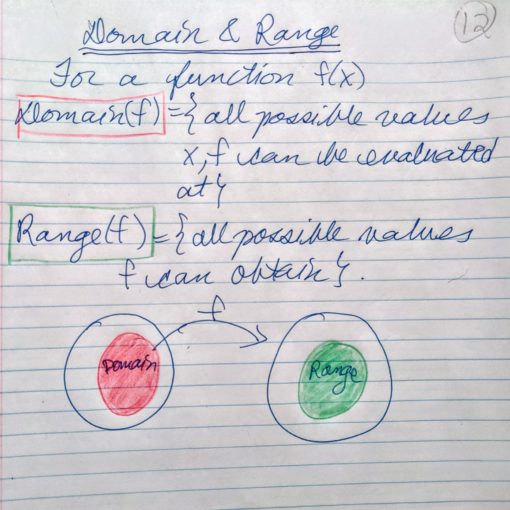Over time I noticed and realized that helping students with math had nothing to do with helping the student with math. It at everything to do with helping the student. While I didn’t know it at the time, I was using approach that was more holistic math tutoring. Considering the student as a whole and providing them with tools, skills, and lessons they will use throughout life. Below are some of the “lessons” that are learnt with a holistic math tutoring approach.
Identifying and Using Resources
Mistakes are OK, more than OK!
Patience can be the Key to Understanding
Identifying and Summarizing Important Points
Lesson: Identifying and Using Resources
In some cases, it was teaching a student how to use their textbook. Where the index is, where the table of contents is, how the chapters are laid out, where to find worked examples like the exercises they were assigned, etc.
Why?
If you don’t know how to use the tools you have, then it’ll be very hard to achieve the results you want. In this case your main tool is your text book. If you don’t have a text book, then you class notes, assignments, tests and quizzes.
Lesson: Communication
Or showing them how to write mathematics and communicate what they were doing, whether it was right or wrong, to the teacher or marker.
Why?
Communication is used everywhere in the world not and in so many ways and mediums. Being able to communicate effectively so that you are understood, will make your life easier. This goes for your math teacher or whoever is grading your work. If you’re able to communicate your reasoning to you math teacher, it will be easier for them to give you a good grade and help you when you get a poor grade. This is where learning and understanding the language of mathematics is valuable.
Lesson: Mistakes are OK
Ensuring the student that making mistakes is ok. And that even if they get stuck on a problem, to write down as much as you can, work through the problem until you are stuck and go on to the next one BUT do not erase or throw out what you have done.
Why?
Do this over and over if you must but keep working through the problems until you get stuck. We will look at them together next time I come and see where you are getting stuck. Sure enough, in most cases, the student was getting stuck at the same spot which usually meant it was the same mistake. So once this was identified the student was able to go back, identify, and correct all the other mistakes. I didn’t have to do it. The student recognized the pattern after we went through one together and felt good about making the correction. A bit of confidence was restored. The student learns to persist, identify a mistake, and make the correction and restoring a bit of confidence.
Lesson: Patience, Slowing Down, and Understanding
Showing the student the importance of reading the question, over and over and over again if needed. There was no shame in slowing down and doing math slowly and their own pace.
Why?
Too many students make ‘silly mistakes” because they are rushing and not fully understanding what is being asked of them. Slowing down, can usually minimize these mistakes by quite a bit. I don’t have actual data to show this, but just by getting a student to re the questions out loud and then reread it to understand what is being asked, can make a big difference as to how they present their final answer.
Lesson: Identifying and Summarizing Important Points
Create a cheat sheet or a formula sheet with formulas, properties, identities, rules, etc. Or procedures to solve a particular type of problem, trigonometric identities, etc.
Why?
There are many formulas and processes for doing thing in mathematics especially as you’re learning. It isn’t necessary to commit everything to memory, especially when you’re just learning. So, create a “cheat sheet” for yourself so you have something to refer to during your own study and practice. The more you refer to the cheat sheet, the more it will become “your” knowledge and by the time you get to your test or exam where you can’t use a cheat sheet, it will already be in your memory and yours.
Lesson: Tactics for Handling Pressure and Anxiety
Test and exam taking tactics both general and specific to the student.
Why?
Everyone is different in how they deal with stress and anxiety. There is no one size fits all. But something that I find works in most cases or at least calms the body down and eventually the mind, is to take a few deep breaths. While it may seem like a waste of time during a test or exam, it only takes a minute and can make all the difference how you read and answer the next questions. I would recommend, if you are feeling nervous or overwhelmed at any time, close your eyes, take a deep and long breath in through your nose and slowly let it out through your lips. Do this a few times until you feel calmer and then open your eyes and resume your test or exam. Think of it as a way of “factory resetting” your mind and body.
Lesson: Confidence and Asking Questions (Take the shot)
Asking questions, how and when in a way that is comfortable for the student’s personality and character.
Why?
If you don’t ask questions, you won’t know. How, when and where you ask the questions will depend on the person. I’ve met many students who feel uncomfortable in class and have tried asking their teacher with no support. This may not be the right person to ask a question to, for now. Start with your parents, guidance counsellor at school. Perhaps if you have a tutor, your tutor. Ask a friend, an older brother or sister. If you play a sport or an instrument or doing anything extracurricular, ask someone there a coach or a music teacher. They may not be able to directly help you, but they can certainly point you in the right direction. If you don’t ask, even if it’s just to ask, “What do I do?” it will start affecting other aspects of you life and it will be harder to enjoy the rest of your day. Math isn’t worth that. However, don’t let math or any subject get to you either. Someone will be able to help, it’s matter of finding the right person. Start by asking any question to anyone.
Lesson: Time Management
Structuring study time and how best to optimize the time and sticking to a fixed amount of time. Learning not to dwell when you get stuck.
Why?
One thing we will always have is 24 hours in a day. Right now when you’re young and in school it may feel like you have all the time in the world. One day you’ll feel like you don’t have enough time. The reality is, that you have the same 24 hour each day. Setting aside a little time each day for your math homework and studies will make a big difference in the long run. For your math, it will give you exposure and practice with the subject that you need to achieve the results you need. The discipline of setting aside time every day to do something that may not be your favorite activity will be something you will be able to do later in life when you have to do something you don’t enjoy but have to do, such as taxes, exercise, wash dishes etc. Time management for homework isn’t just because you have to get a good grade in math but for the rest of your life so you can do the best at living your life.
I am sure there are many other lessons that were learned along the way, but these were just a few that come to mind and that I have experienced and have seen first hand.
Conclusion
A “holistic math tutoring approach” is all about how succeeding in math isn’t just about knowing formulas—it’s about using the right tools and strategies for the problem at hand. It talks about the importance of learning how to use resources, you textbook, and communicating clearly so you are understood, your teacher in this case. Mistakes? Totally normal and part of the process. Taking your time, being patient, and creating studying aids to help tough topics are also encouraged. Managing stress during exams, asking questions, and using time wisely are also big takeaways that cab be used in other situations. In the end, a diganostic math tutoring approach combined with a holistic math tutoring approach is all about building your confidence and life skills, not just aceing math. Good grades are a pleasant side effect.




